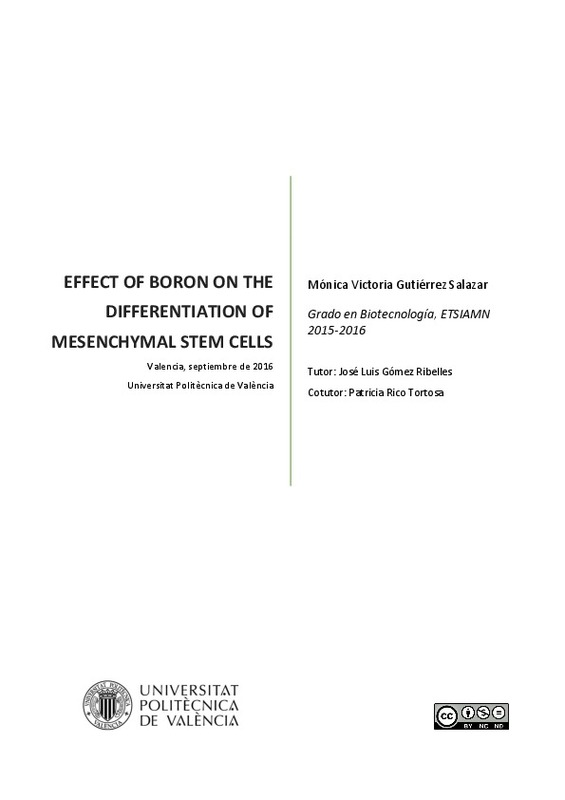JavaScript is disabled for your browser. Some features of this site may not work without it.
Buscar en RiuNet
Listar
Mi cuenta
Estadísticas
Ayuda RiuNet
Admin. UPV
Effect of boron on the differentiation of mesenchymal stem cells
Mostrar el registro sencillo del ítem
Ficheros en el ítem
| dc.contributor.advisor | Gómez Ribelles, José Luís
|
es_ES |
| dc.contributor.advisor | Rico Tortosa, Patricia María
|
es_ES |
| dc.contributor.author | Gutiérrez Salazar, Mónica Victoria
|
es_ES |
| dc.date.accessioned | 2016-10-17T07:25:15Z | |
| dc.date.available | 2016-10-17T07:25:15Z | |
| dc.date.created | 2016-09-29 | |
| dc.date.issued | 2016-10-17 | es_ES |
| dc.identifier.uri | http://hdl.handle.net/10251/71884 | |
| dc.description.abstract | [EN] Boron is an essential microelement in the metabolism of living organisms. However, its role is not yet well defined. It has been shown recently that boron has a positive effect on the differentiation on murine myoblasts and it is known that it is involved on bone mineralization. For that reasons, it is done here a research using different concentrations of boron in a material system composed by PLLA (polylactic-L-acid) as a substrate, in order to verify if boron has also an effect on the differentiation of mesenchymal stem cells to different lineages (myoblast, osteoblast, adipocyte or for the contrary stemness maintenance). With this, it could be favored the regeneration of both damaged muscle tissue and bone tissue, achieving in that way an important progress on tissue engineering, adding to the current techniques just a microelement. | es_ES |
| dc.description.abstract | [ES] El boro es un microelemento esencial en el metabolismo de los seres vivos, aunque su papel en este no está bien definido. Se ha demostrado recientemente que el boro tiene un efecto positivo en la diferenciación de mioblastos murinos, y se sabe que interviene en la mineralización del hueso. Por ello, se realiza aquí un estudio empleando diferentes concentraciones de boro y PLLA (ácido-L-poliláctico) como soporte, con el fin de comprobar si el boro tiene también un efecto en la diferenciación de células madre mesenquimales hacia varios linajes diferentes (mioblasto, osteoblasto, adipocito o por el contrario mantenimiento de las células en su estadío indiferenciado). Se podría con ello favorecer la regeneración tanto de tejido muscular como tejido óseo dañado, consiguiendo así un avance importante en la ingeniería de tejidos, añadiendo a las técnicas actuales tan solo un microelemento. | es_ES |
| dc.format.extent | 53 | es_ES |
| dc.language | Inglés | es_ES |
| dc.publisher | Universitat Politècnica de València | es_ES |
| dc.rights | Reconocimiento - No comercial - Sin obra derivada (by-nc-nd) | es_ES |
| dc.subject | Differentiation | es_ES |
| dc.subject | Boro | es_ES |
| dc.subject | Diferenciación | es_ES |
| dc.subject | Células madre mesenquimales | es_ES |
| dc.subject | PLLA | es_ES |
| dc.subject | Boron | es_ES |
| dc.subject | Mesenchymal Stem Cells | es_ES |
| dc.subject.classification | MAQUINAS Y MOTORES TERMICOS | es_ES |
| dc.subject.other | Grado en Biotecnología-Grau en Biotecnologia | es_ES |
| dc.title | Effect of boron on the differentiation of mesenchymal stem cells | es_ES |
| dc.type | Proyecto/Trabajo fin de carrera/grado | es_ES |
| dc.rights.accessRights | Abierto | es_ES |
| dc.contributor.affiliation | Universitat Politècnica de València. Departamento de Termodinámica Aplicada - Departament de Termodinàmica Aplicada | es_ES |
| dc.contributor.affiliation | Universitat Politècnica de València. Escuela Técnica Superior de Ingeniería Agronómica y del Medio Natural - Escola Tècnica Superior d'Enginyeria Agronòmica i del Medi Natural | es_ES |
| dc.description.bibliographicCitation | Gutiérrez Salazar, MV. (2016). Effect of boron on the differentiation of mesenchymal stem cells. http://hdl.handle.net/10251/71884. | es_ES |
| dc.description.accrualMethod | TFGM | es_ES |
| dc.relation.pasarela | TFGM\46340 | es_ES |
Este ítem aparece en la(s) siguiente(s) colección(ones)
-
ETSIAMN - Trabajos académicos [3541]
Escuela Técnica Superior de Ingeniería Agronómica y del Medio Natural






